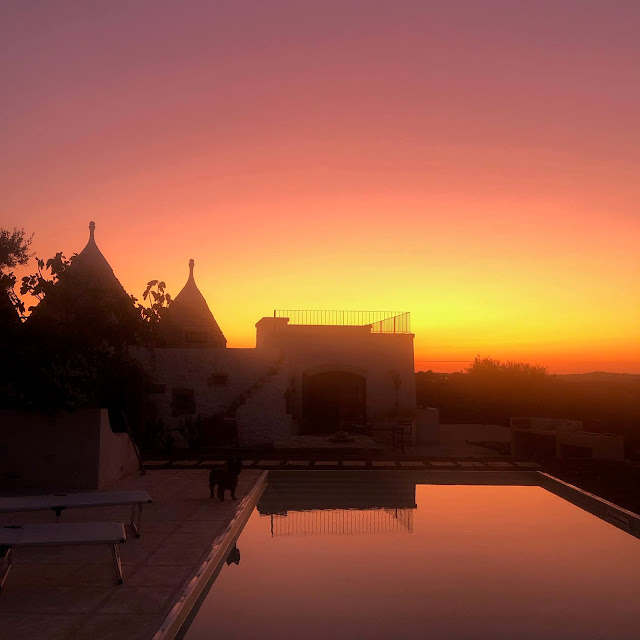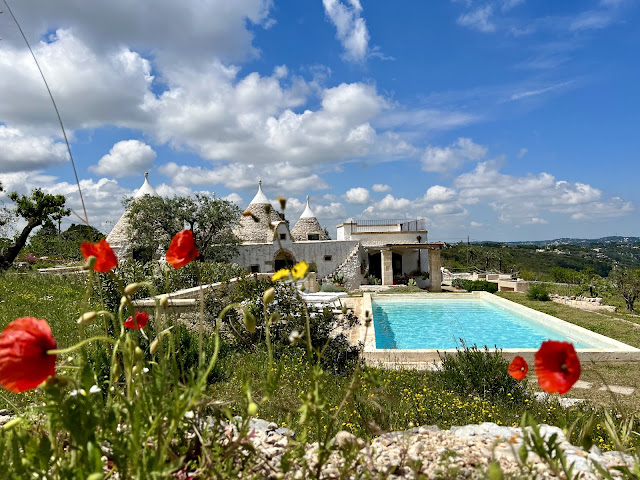Serendipity strikes again
The other night still slightly on edge due to yet another builder no-show, we were readying to make an aperitivo when we heard voices and sent Sherlock to investigate.
A trio of smiling faces - one woman and two men - had walked up the driveway and asked if they could look around.
“Venite, ben venuti” I said.
“Welcome, of course come in and have a look!”
To cut a long story short, the three – Matteo, Sofia and Alberto – had gone exploring and had happened on our little slice of madness, er paradise, that morning. We were not home then and so, they’d come back to see if they could take a closer look, inside and out.
As we walked them around our trullo, it was met with warmth and enthusiastic approval by all three who were not only generous in their observations but exuded genuine interest. It seems they understood instinctively our desire to ensure that the spirit and humble origins of this buiding be preserved. For us, it was a fillip, an unexpcted and joyous pat on the back from strangers for our efforts to honour the agricultural architectural vernacular at a time when the battle to finish the bloody thing still feels pretty raw.
We chatted for a while, enjoyed the end of the sunset together and then they headed off into the darkness.
The following day, a surprise WhatsApp message arrived asking us to join them for dinner at Matteo’s house in nearby San Marco. This show of hospitality and generosity from people we had just met felt like another gift and when we arrived last night, well, I have to say his family’s trullo – built by his grandfather 200 years ago – is one of the most beautiful, unique and narrative laden buildings I’ve ever been in.
My photos are rubbish, shot off quickly and in bad light so bear with me….let's see if I can do it justice through the tales.

Matteo laughs that the Puglian tradition in which the father builds a house for his first-born son was effectively the saviour of the family trullo: "My father put his concentration on the house over there" he said pointing behind him. "Which means he left the trulli alone!" he laughed.
The reality is that while thousands of trulli have been abandoned all over the region, many more were modernised in the 1960s and 70s as their owners, understandably, wanted to improve their way of life, moving from difficult- to-maintain stone floors to modern tiles, adding bathrooms, removing wood ovens and chimneys, wells and stone cisterns to make day-to-day chores easier and the return from the fields more comfortable. It is not a judgement, after all, we (and Matteo and his family) now live the trulli in summer, for holidays and when they are at their best as cooling, stone buildings not as a permanent home in the cold and damp of winter after toiling the fields and vineyards.
But with change came the loss of evidence of a way of life, of architectural detail that told the stories of how people lived at another time in history, of familial happenings and local events that imprint themselves indelibly in a house.
Matteo and his family's trullo is a palimpsest and each room is associated with the cycle of life, of births and deaths, joys and tragedies and each utilitarian changes to the trulli archiecture reflected the changing needs of the inhabitants at particular times.
Here, he said as he showed us the main bedroom is the place where babies were made - great grandparents and grandparents only slept there on certain nights. Otherwise, they slept opposite each other, on beds carved out of the stone niches but separated by a fire and hearth - 19th century contraception pretty much!
 |
| Matrimonial |
 |
| Grandpa's niche (with added leg room at right). Hearth at right, Grandma had the same, opposite sans leg room! |
Matteo pointed to the left side, with its longer length - he is well over 6 foot two as was his grandfather so they carved space out of the stone for him to lie comfortably!
During wartime, grain was worth gold - a stone wall was created with a hole at the top where grain and flour were poured and stored - invisible to marauders.
Water is precious in these parts, cisterns often beneath the trulli collected rainwater from the rooves and to keep it fresh, a couple of eels were always kept in the wells to ensure the water was moved around, didn't stagnate and insects kept down. A ledge jutting out of a wall seemingly for no reason turned out to be a little roof for the dog's kennel - long filled in.
In the main bedroom, a deep hole in the thick stone wall...a safe, for money, in the past covered with wood. In another niche high above the ground, a ceramic vase unreachable in the parents main bedroom. Why? So biscuits or special treats could not be reached by little hands at night. The wood oven was often shared by several families - so everyone had their own special mark they'd put in their bread dough to identify which loaf belonged to whom!
 |
| Safe for valuables |
 |
| Biscuit jar in parental bedroom, too high for little hands |
 |
| The door to the trullo oven shared by many families in the past. Inside it's huge |
 |
| The stone at left opens to the cavern below where raw grapes were poured into vast ceramic vases |
I could go on because Matteo's stories were so delightful that I could have listened all night but my photos are lacking... grrr I normally snap away madly but was listening too intently and forgot!
The group of friends all work in the north of Italy but spend their summers here and each year, Matteo and his sister and Stefania his partner have done careful, gentle work/projects to maintain and make the building even more delightful (if that is possible). (The bathrooms are divine). Alberto, his friend, is a designer, a curator of architectural spaces and a brilliant, prize-winning one at that and Sofia too although in apparel - their friendship made such sense.
So, last night we all sat in the courtyard and ate Puglian delights, cheeses, capocollo, the pork meat known in this region, fresh almonds, bombette barbecued, mozzarella all manner of delights - and they shared their providores and where to find the best bits and pieces. I now know the very best bar to have morning coffee (where the locals are punsters and joking accompanies the morning caffeine rituals) and later today, we're off to see an exhibition of historic trulli photographs which opens today and we'd never have known about had they not ventured in to say hello. Sherlock had a lovely time with young Leonardo who threw sticks for him and tomorrow, I'm off to buy a rusty cistern base to make my own fire pit! (Another handy tip from Matteo!) If I were a magazine editor, I'd be doing a photographic essay on this house...
I've gone on enough about last night but suffice to say it was magic. Thank you to new friends - and isn't serendipity a marvellous thing!









you should totally flog this as an article to a homes website.
ReplyDelete